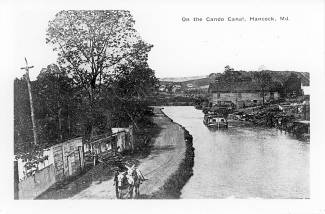Collection Name
About
Shanties and warehouses often dotted the canal on both the towpath and berm side. This photograph illustrates the sometimes crowded canal area. The mules are driven in tandem with a single swing tree connected both harnesses to the towrope attached to the canal boat. When boats traveling opposite directions met the lighter boat would swing over to the berm side and unhook their mules from the tow rope. The loaded boat would stay near to the towpath and travelled over the light boat tow rope. The term “dunking the rope” is in reference to keeping the tow rope wet and heavy enough to sink to the bottom of the canal if two boats met.
The building on the right is the Taney Warehouse. It was built around 1878 and was owned by Raphael E. Taney (1838-1913) but was rented out to tenants. Taney had a general merchandise store on Main Street and was a wholesale whiskey merchant. He also ran Taney’s Tavern. The warehouse was reduced in size in 1936 when the road next to the canal was built (Hahn).
123.84 Mile
Other general merchandise stores in the area included Samuel Rinehart & Son, Hedding & Koontz, and Stigers & Swingle (Hancock Messenger, 9-18-1923). The Illustrated Atlas of Washington County, Maryland, published in 1877 by Lake, Griffing & Stevenson, shows Daniel Seavolt, and Louce & Son as general merchants in Hancock and S. Bowles miller and grain dealer, Solomon Jenks, furniture maker and undertaker and Samuel Fortner, wagon maker.
